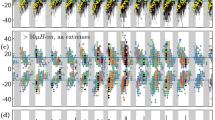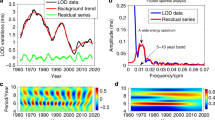Abstract
THE geophysical element which has thus far shown -L the most marked correlation between manifestations of solar activity, as, for example, sunspotted-ness and prominences, is some measure of activity of the earth's magnetism. The range of the magnetic diurnal variation, as shown by observations extending over nearly a century, is known to pass through a definite fluctuation to the extent of 50 per cent., or more, during a sunspot cycle. The synchronism between the solar curve and the magnetic curve is not exact, however, the times of maxima of the two curves differing not infrequently by one year or more. Thus, at the Kew Observatory the absolute daily range of the magnetic declination during the period 1858–1900, or approximately 4 sunspot cycles, passed through a maximum value, three times out of the four cases, one year in advance of the sunspot maximum. During the recent sunspot cycle (1913–1923) the maximum magnetic activity showed a lag of two years with reference to the solar curve. In 1893, when sunspottedness was a maximum, the earth's magnetic activity, after having been increasing for several years previous, was quite markedly lessened, and then rose to a maximum value in 1894.
This is a preview of subscription content, access via your institution
Access options
Subscribe to this journal
Receive 51 print issues and online access
$199.00 per year
only $3.90 per issue
Buy this article
- Purchase on Springer Link
- Instant access to full article PDF
Prices may be subject to local taxes which are calculated during checkout
Similar content being viewed by others
References
Presented before the joint meeting of the American Physical Society, the American Astronomical Society, and Sections B (Physics) and D (Astronomy) of the American Association for the Advancement of Science, Washington, D.C., December 30, 1924.
See footnote 1.
Terr. Mag. and Atmos. Elec., vol. 29 (1924), pp. 23–32 and 161–186
Table I. was derived from the values of s given in extenso in the author's Table 7, p. 171, Terr. Mag., vol. 29, p. 171.
See Fig. 2, Terr. Mag., vol. 29, p. 31.
While s for cycle No. 7 was only about one-half of that for No. 6, the total electrical output during each cycle may have been about the same. Thus if R is the range or difference in sunspot number between minimum and maximum, then we have for No. 7, Rs = 102 × 0.24 = 24, and for No. 6, Rs = 61 × 0.49 = 30.
See Terr. Mag., vol. 29 (1924), p. 181.
Terr. Mag., vol. 29 (1924), pp. 175–179.
Author information
Authors and Affiliations
Rights and permissions
About this article
Cite this article
BAUER, L. Further Evidence Regarding the Correlation between Solar Activity and Atmospheric Electricity. Nature 115, 537–540 (1925). https://doi.org/10.1038/115537a0
Issue Date:
DOI: https://doi.org/10.1038/115537a0
Comments
By submitting a comment you agree to abide by our Terms and Community Guidelines. If you find something abusive or that does not comply with our terms or guidelines please flag it as inappropriate.



